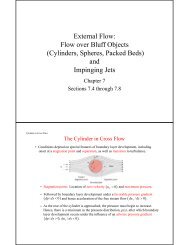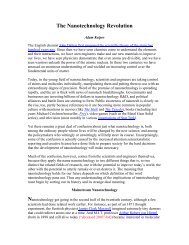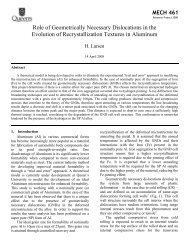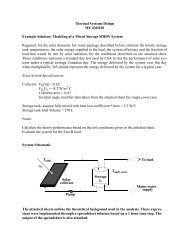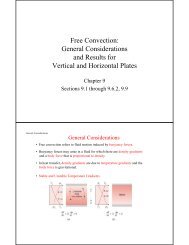Numerical Study of Passive and Active Flow Separation Control ...
Numerical Study of Passive and Active Flow Separation Control ...
Numerical Study of Passive and Active Flow Separation Control ...
You also want an ePaper? Increase the reach of your titles
YUMPU automatically turns print PDFs into web optimized ePapers that Google loves.
Fig. 20. Mean pressure coefficient <strong>of</strong> Case 1<br />
in comparison with baseline case<br />
24<br />
Fig. 21. Mean skin friction coefficient <strong>of</strong> Case 1<br />
in comparison with baseline case<br />
Fig. 22 shows the chord-wise distribution <strong>of</strong> the peak turbulence kinetic energy k <strong>of</strong><br />
Case 1 in comparison with that <strong>of</strong> the baseline case. In Case 1, k increases sharply at x º<br />
0.24C, about the same location in the baseline case. It should be noted that the passive<br />
vortex generators only reduce the size <strong>of</strong> the natural separation bubble <strong>and</strong> there are still<br />
two small separation bubbles remaining in the time <strong>and</strong> spanwise averaged result as<br />
shown in Fig. 18. In this case, the high momentum transferred from the freestream by<br />
vortices created by the passive vortex generators reattaches the separated laminar flow<br />
forming the first bubble between x = 0.06C <strong>and</strong> x = 0.11C. But the reattached laminar<br />
flow is not able to resist the adverse pressure gradient downstream <strong>and</strong> it separates again<br />
from the airfoil surface near x = 0.21C. The separated shear layer undergoes transition<br />
which leads to reattachment at x = 0.25C forming the second bubble as shown in Fig. 18.<br />
In this case, as displayed in Fig. 22, transition in the second separated shear layer occurs<br />
at approximately the same location as in the baseline case. It is possible that the vortices<br />
created by the passive vortex generators bring more energy to the transition process such<br />
that the maximum peak k is almost three times higher than that <strong>of</strong> the baseline case.






